Analysis: Seahawks Cover 3 Coverage Bust vs. 49ers Explained
The Seahawks' defense played some actual defense on Sunday. Their performance in the 28-21 victory over the 49ers arrived as a welcome reassurance, acting as a tonic to the anguish caused by the defensive horror show that was Week 3. Seattle’s Week 4 defense survived a shaky opening drive and a lack of complementary football from a stagnant offense, executing to get off the field.
The defensive bust, therefore, was an anomaly and not the norm like mistakes had been the prior week. The momentary blip does matter, yet the coverage mistake is more indicative of the challenges that a newcomer to the defense raises than that of a deeper, more problematic issue. Sidney Jones, acquired late in the offseason from the Jaguars in exchange for a sixth-round pick, received his first start at left cornerback. On the bust, Jones messed up.
DEEBO IS WIDE OPEN.
— NFL (@NFL) October 3, 2021
Trey Lance finds him for the 76-yard TD! #FTTB
📺: #SEAvsSF on FOX
📱: NFL app pic.twitter.com/9BRzRkYRNU
“Sidney had a challenging day, you know he had a challenging day,” head coach Pete Carroll told 710 ESPN Seattle on his weekly visit with host Mike Salk. “He had a couple of plays that got away from him, but all in all he did a nice job, played the scheme well with the exception of the one big touchdown.”
The scheme on “the one big touchdown” was cover 3 pass defense. Jones, to the slot, multiple receiver look, should have immediately gone into a “zebra” mindset where he adjusted his deep 1/3 to play more like a pure zone, looking to midpoint the two receiving threats deep, playing 60-40 to the No. 2 receiver.
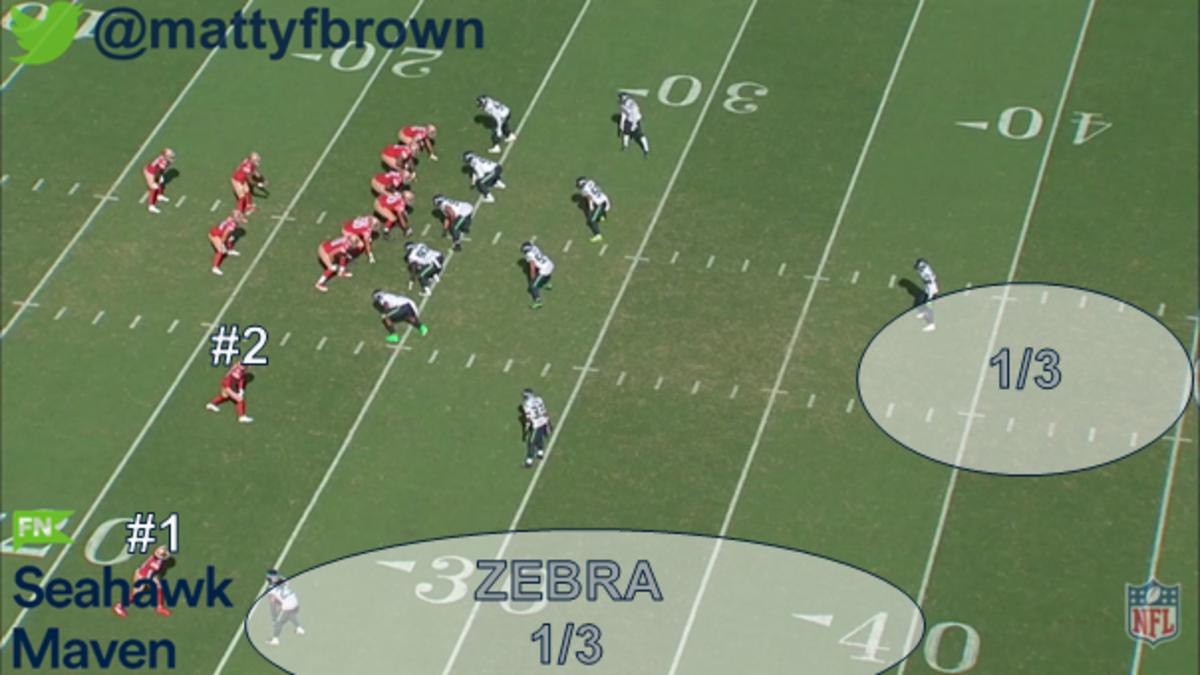
Regardless of whether Jones had these “zebra” intentions pre-snap or not, his expectation in the cover 3 defense seemed to be that the curl-flat, outside underneath space defender—what Seattle calls a “buzz” technique—would be responsible for taking the wheel route from the No. 2 receiver up and through his zone, matching it down the field. This would then free up the deep 1/3 cornerback behind, not having to worry about the No. 2 receiver, to then squeeze the No. 1 receiver more aggressively.
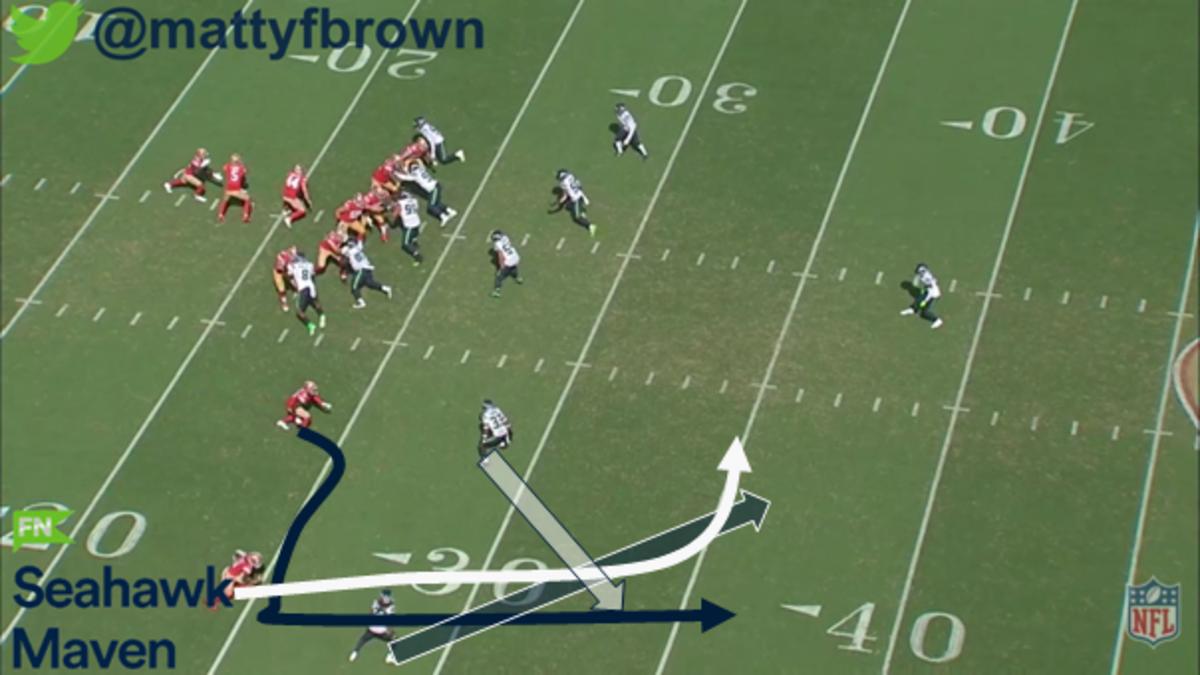
Strong safety Jamal Adams was the buzz defender on this play. Yet he stopped visioning the No. 2 receiver, Deebo Samuel, once he had expanded, instead passing off the wheel route with supreme confidence while maintaining quarterback vision. After the play, Adams was distraught with frustration that Jones did not move over to Samuel.
Jones likely defaulted to generic cover 3 rules, not registering the full picture on the play. Meanwhile, Adams likely did not double check with Jones to make sure he was aware of the assignment, instead presuming that Jones was locked in to the gameplan.
“Just, I think, feeling out how everything moves and your teammates, and all the small details and communication part of it,” Jones said of the biggest challenge of joining a new team in his postgame press conference. “It’s one thing to have a playbook, it’s different to actually go out and execute with other people, 11 other men—10 other men—and do it all collectively together.”
After the win, free safety Quandre Diggs refused to assign individual blame on the play.
“You must think I’m a snitch," Diggs joked.
Diggs, though, took individual responsibility for the play because he was on the sidelines, leaving Marquise Blair at free safety. “Communication” was mentioned again.
“I feel like if I was in, it would have been a little bit better communication,” Diggs said. “Not saying that they didn’t, but it’s my job to lead back there and I wasn’t out there, so I put that on me.”
Repeated communication, to the point that it becomes over the top, is the key to avoiding basic coverage busts. When asked about working with Jones in the defense, Diggs repeated his emphasis on communication.
“I think for us it’s just continuing to communicate with [Jones], so when we do get in the heat of battle, he knows exactly what he’s doing and we can’t put him in those positions where he doesn’t,” the free safety stated postgame. “So, I think as time continues to go, you know, we’ll get better communication and I think he’ll be playing a lot better and I’m excited to have him, you know?”
— Ultra Rare Tape (@UltraRareTape) October 5, 2021
So why would Seattle not have Adams carry the wheel route on this play, an “indicator” they use in their defense to match the route with this defender? Answering this question is where the real proof of Jones’ mistake lies.
“It depends on the situation and the call,” Carroll responded on Monday when questioned on whether the curl-flat defender should run with a wheel route. “We have different ways that we do it. And, you know, some teams might always do it the same way, we don’t. We have a couple of different ways that it comes out. Depends on how we control the zone approach to it. There’s different things that we do. Sometimes we man it up, and sometimes we don’t, it depends.”
The 49ers' situation was noteworthy. They aligned in a pair tight end, nub 2x2 look via 21 personnel that they quickly shifted into a pistol offset weak formation—a two-back look that put fullback Kyle Juszczyk to the side of Adams.
“I think, the way the defense works, it all works together,” Jones said after the bust. “We have to go to the film room and figure that out and I have to do a better part of my job in recognizing the formation and play and, you know, clean that up.”
The cornerback clearly did not observe the ramifications of the 49ers’ formation or personnel. It meant he would be required to play pure zebra 1/3, midpoint technique and would not be receiving help with the wheel route from Adams.
“You know, going into it, we knew what type of quarterback Lance was, and we knew what Jimmy was,” Adams declared afterwards. “We were prepared for both.”
Seattle’s gameplan and defense adjusted well for the different style of 49ers rookie quarterback Trey Lance's attack, where Lance’s mobility is a major factor in the run game.
“When they made the switch, we, obviously, we wanted to feel what they were doing and obviously they started to do a lot of zone read and get in two-back, you know obviously getting things around the edge and letting him keep the ball as well,” Adams continued. “So it was a different attack, obviously.”
Adams’ mention of “two-back” applies here. With Juszczyk towards him, this created an extra gap to be accounted for.
And, while Diggs refused to snitch on a teammate, his answer on playing Lance revealed a telling detail.
“I mean, we talked about it in the week,” Diggs revealed of the planning for Lance. “So our coaches had us well prepared for that and it’s up to, you know, myself, Bobby [Wagner], Jamal, 'Big Al' [Woods] and Poona [Ford] just to relay it through the rest of the defense and just let guys know that, you know, we got some different fits when he comes in the game, and kinda more of a college-style offense when he comes in the game.”
The “different fits” are relevant to the bust too. Lance being used in the run game as a runner creates another extra gap that the defense must account for. Meanwhile, 49ers head coach Kyle Shanahan will attach routes to running plays to create more room. If Adams had been matching the wheel route versus this formation and Lance in a run play, there would have been no player for Lance.
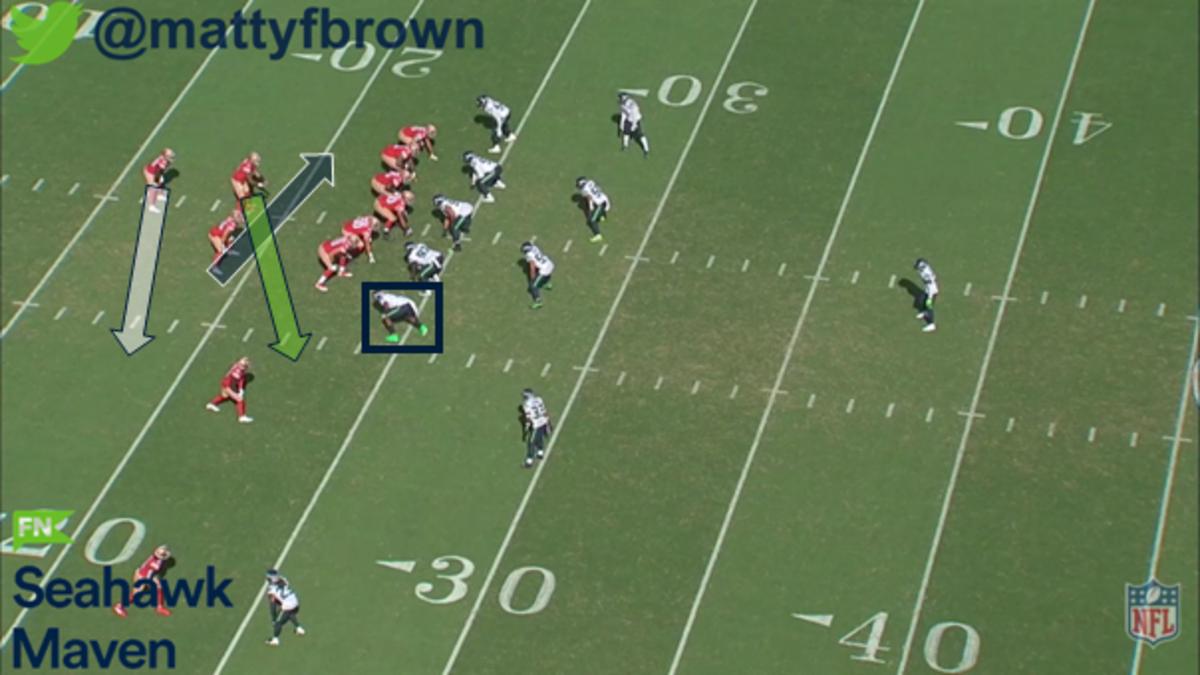
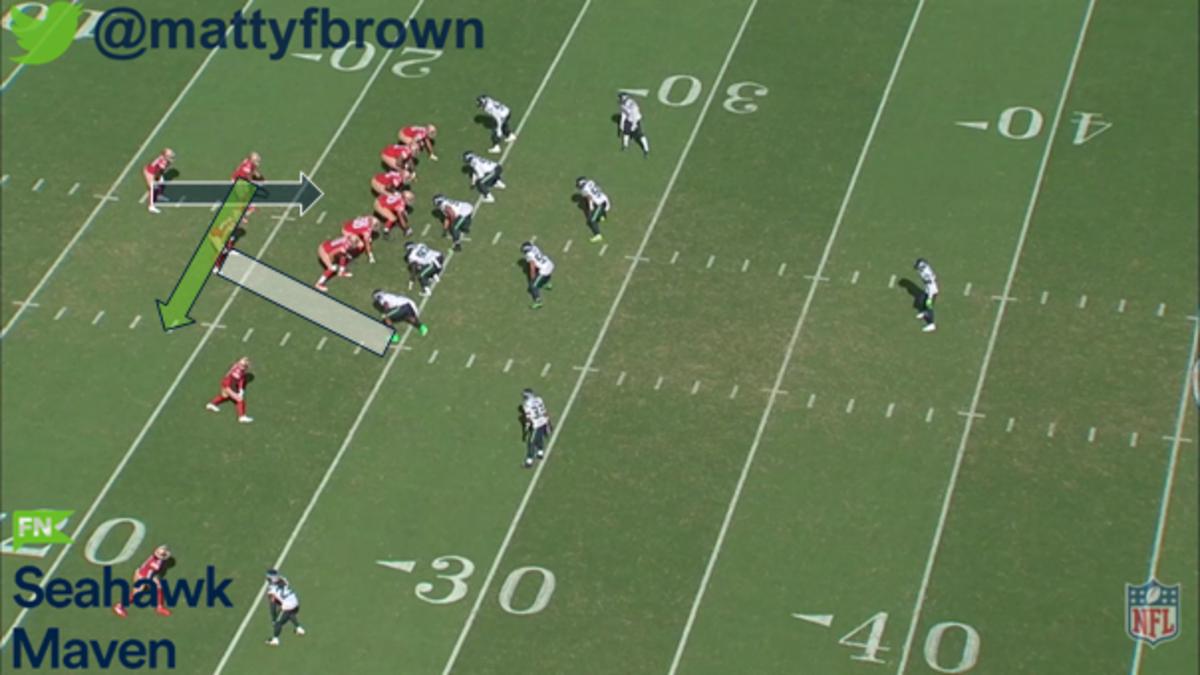
Plus, given Lance’s threat as a scrambler, it makes even more sense that the Seahawks did not want their underneath layers getting run off with their eyes away from the quarterback—especially on the edge of their defense.
You can see pre-snap that Adams checked with Blair at deep safety to alert him that he was not going to be matching a wheel route from the No. 2 receiver. With the free safety’s role to stop seam and post routes, Blair only had one seam route threat versus the 2x1 receiver distribution. Therefore, he was able to lean his focus to that side of the field, freeing Adams and Jones to play more pure zone principles.
Adams checked with Diggs versus a similar two-back look. In this play, you can see Adams gestured pre-snap with his hand to make sure Diggs was aware of the lone seam threat and Adams' technique. With Seattle in their under zone x family, Jordyn Brooks was stacking the C-gap and Wagner the A-gap—meaning once more that Adams was very much required as a reliable, present plus-one defender in the run fit.
— Ultra Rare Tape (@UltraRareTape) October 5, 2021
Versus this two-back pistol formation, Adams looked to maintain inside leverage on the No. 2 receiver and play in the run fit.
— Ultra Rare Tape (@UltraRareTape) October 5, 2021
Lastly, here is a situation where Adams, in under zone x defense, entered the box due to the offense’s 22 personnel pair.
— Ultra Rare Tape (@UltraRareTape) October 5, 2021
In the past, when in this kind of cover 3 rotation to a slot, two-back formation, Seattle has checked "mix" (two-read pass coverage with three defensive backs) to keep the strong safety firmly in the run fit, yet also get three defenders over the two threats while protecting versus the No. 2 receiver bubble.
The strong safety plays with inside leverage on the slot receiver. The cornerback keys and mirrors the slot receiver, jumping the route if he is out within two yards. And the free safety keys the slot receiver, matching his release and moving to cover the outside receiver if the slot is out within the five-yard mark.
Returning to the coverage bust, Jones’ mistake should be cleaned up quickly.
“It’s just first-time-out stuff,” Carroll agreed on Monday.
The Seahawks' defense should pay attention to the comments of Diggs and Jones, though. Frequent, effective communication is vital to sound defense and this is especially true with a new face in the lineup.
